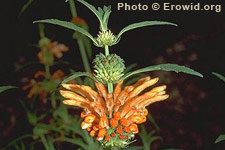[SIZE=-1]SWIM has found a little gem relevant to this discussion and has tried to make it a little bit easier to for You to read. The pharmaceutical information is near the bottom.[/SIZE]
[SIZE=-1]LEONOTIS LEONURUS HERBA[/SIZE]
[SIZE=-1]Definition[/SIZE]
[SIZE=-1]Leonotis herba consists of the dried aerial parts of Leonotis leonurus (L.) R. Br. (Lamiaceae).[/SIZE]
[SIZE=-1]Synonyms[/SIZE]
[SIZE=-1]Phlomis leonurus L.[/SIZE]
[SIZE=-1]Leonotis leonurus (L.) R. Br. var. albiflora Benth.[/SIZE]
[SIZE=-1]Vernacular names[/SIZE]
[SIZE=-1]wilde dagga (A), lion's ear, minaret flower (E), unfincafincane (X), lebake (S), umhlalampetu (Sh)[/SIZE]
[SIZE=-1]DESCRIPTION[/SIZE]
[SIZE=-1]Macroscopical[/SIZE]
[SIZE=-1]Shrub 2-5 m tall, branching from a thick woody base; stem pale brown and densely pubescent; leaves simple, opposite, petiolate, coriaceous, 50-100 ´ 10-20 mm, linear, acute at apex and base, serrate in the distal half; upper surface bright green, lower surface densely pubescent; inflorescence of 3-11 compact verticils; calyx 12-16 mm long, 4 mm in diameter, calyx teeth 10, subequal, spreading; corolla tubular, bright orange, 40-49 mm long, covered with orange hairs; fruit a nutlet 5-6 ´ 1.5-2 mm, brown.[/SIZE]
[SIZE=-1]Microscopical[/SIZE]
[SIZE=-1]Characteristic features are: the numerous uniseriate, curved, thick-walled, warty, 2-3 celled non-glandular trichomes of leaf and stem, 60-100 m in length, particularly abundant on margin of lamina and main veins of lower leaf surface; the numerous glandular hairs of leaf and stem, with unicellular stalk and 4-celled head (up to 20 m in diameter) and yellow-brown contents; the less numerous glandular trichomes of leaf lamina, with unicellular stalk and 6-8 celled head, thick-walled, head about 40 m in diameter; cells of the lower epidermis with sinuous walls and striated cuticle, lacking stomata; cells of the upper epidermis with sinuous walls and numerous raised anomocytic stomata; single palisade layer; abundant crystal sand in cells of the mesophyll; occasional yellow hairs of the corolla.[/SIZE]
[SIZE=-1]Crude drug[/SIZE]
[SIZE=-1]Supplied in bundles comprising young leafy twigs, the leaves having a characteristic aromatic-pungent odour, bright yellow-green colour and rough texture; occasional flowers and fruits are present. [/SIZE]
[SIZE=-1]Geographical distribution[/SIZE]
[SIZE=-1]Locally common at forest margins, on rocky hillsides and river banks and in tall grassland of the Eastern and Western Cape Provinces, Kwazulu-Natal and Mpumalanga.[/SIZE]
[SIZE=-1]QUALITY STANDARDS[/SIZE]
[SIZE=-1]Identity test[/SIZE]
[SIZE=-1]Thin layer chromatography on silica gel using as solvent a mixture of toluene:diethyl ether:1.75m acetic acid (1:1:1). Reference compound: thymol (0,1% in chloroform)[/SIZE]
[SIZE=-1]Major compounds:[/SIZE]
[SIZE=-1]yellow-mustard (Rf :0,19); yellow-mustard (Rf: 0,38); blue-mauve (Rf: 0,4); thymol (pink): Rf:0,8.[/SIZE]
[SIZE=-1]Ethanol (70%) extractive value[/SIZE]
[SIZE=-1]not less than 22%[/SIZE]
[SIZE=-1]Volatile oil content[/SIZE]
[SIZE=-1]not less than 0,15% (0,15-0,18%).[/SIZE]
PURITY TESTS
[SIZE=-1]Major chemical constituents[/SIZE]
[SIZE=-1]1. Diterpenoid labdane lactones: premarrubiin 0.00933-0.01567%, marrubiin (possibly an artifact derived from premarrubiin during extraction)[/SIZE]
[SIZE=-1]2. Tannins, quinones, saponins, alkaloids and triterpene steroids were detected in preliminary tests in our laboratories; iridoids were not detected.[/SIZE]
[SIZE=-1]MEDICINAL USES[/SIZE]
Dosage forms
[SIZE=-1]Used mainly in the form of an aqueous decoction, orally, per rectum and as a topical application. [/SIZE]
[SIZE=-1]Internal[/SIZE]
[SIZE=-1]For the treatment of cough, cold, influenza, chest infections, diabetes, hypertension, eczema, epilepsy, delayed menstruation, intestinal worms, constipation, spider bites and scorpion stings and as an antidote for snakebite.[/SIZE]
[SIZE=-1]External[/SIZE]
[SIZE=-1]For the relief of haemorrhoids, eczema, skin rashes and boils.[/SIZE]
[SIZE=-1]Pharmacology / Bioactivity[/SIZE]
Anti-nematodal activity has been demonstrated in vitro against Caenorhabditis elegans for aqueous and 100% ethanol extracts of the dried aerial parts of South African plants, at concentrations of 1.0mg/ml. A hexane extract proved inactive at a concentration of 2.0mg/ml. The same study found water and ethanol extracts to be inactive in an in vitroassay for anti-amoebic activity.
Molluscicidal activity of 80% ethanolic extracts of dried leaf, stem and fruits of Sudanese plants against Biomphalaria pfeifferi and Bulinus truncatus could not be demonstrated in vitro (concentration 200mg/litre). Anticonvulsant activity of an aqueous extract of dried leaf has been demonstrated in vivo in the mouse (dose: 200.0mg/kg IP) . In an in vitro assay for antiphage activity of aqueous fresh leaf+stem extracts of Greek plants, no activity was demonstrated against Bacteriophages MS2, PHI-CHI-174, T-7, T2, T4 or Bacteriophage-OPS7 . Extracts of shade-dried roots of Ethiopian plants were examined for anti-fertility activity in the rat, both in vitro (uterine stimulant activity) and in vivo(anti-implantation effects). Weak uterine stimulant activity was shown for 95% ethanol extracts but not for aqueous or n-butanol extracts (conc. 2.0%). Anti-implantation activity was shown by both n-butanol nd (%% ethanolic axtracts but not by aqueous extracts (dose: 0,93g/kg intragastrically) .
ASSAY
[SIZE=-1]Brine shrimp lethality assay[/SIZE]
[SIZE=-1]preliminary results showed no effect on brine shrimps in the concentrations tested.[/SIZE]
[SIZE=-1]Antibiotic activity assay[/SIZE]
[SIZE=-1]No in vitro antimicrobial activity was observed in preliminary assays, in the concentrations used.[/SIZE]

